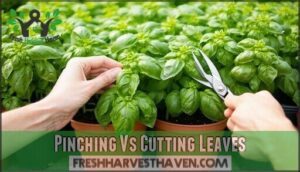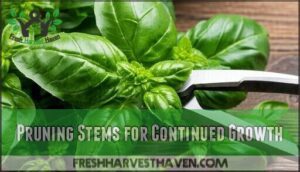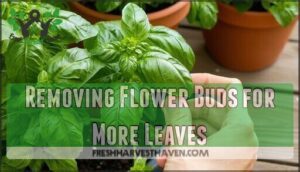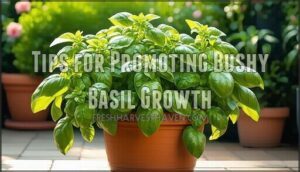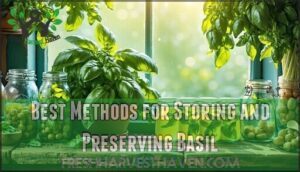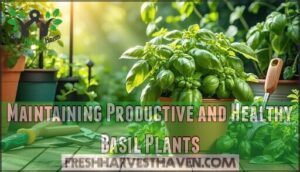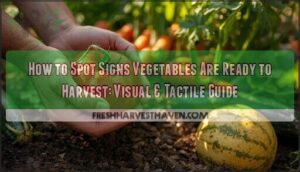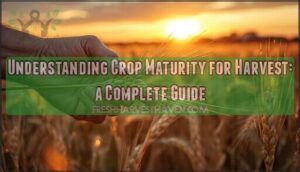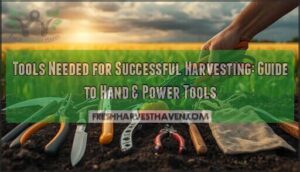This site is supported by our readers. We may earn a commission, at no cost to you, if you purchase through links.
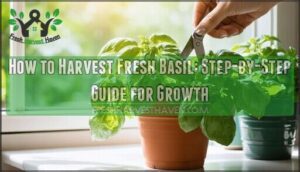
The difference comes down to knowing exactly where to cut, when to snip, and which leaves to target. Most gardeners don’t realize that harvesting fresh basil isn’t just about taking what you need—it’s actually how you train the plant to grow stronger and produce more.
Once you learn the simple techniques that encourage branching and prevent flowering, you’ll turn a single basil plant into a continuous supply of aromatic leaves.
Table Of Contents
- Key Takeaways
- When and How to Harvest Fresh Basil
- Essential Harvesting Techniques for Basil
- Tips for Promoting Bushy Basil Growth
- Best Methods for Storing and Preserving Basil
- Maintaining Productive and Healthy Basil Plants
- Frequently Asked Questions (FAQs)
- Is it better to dry or freeze basil leaves?
- How do you pick basil so it keeps growing?
- How do you store fresh basil after picking?
- Is it better to freeze basil or dry it?
- When should you not eat basil leaves?
- What is the best way to pick basil?
- How do you harvest basil without killing the plant?
- How do you cut fresh basil?
- How to trim a basil plant so it keeps growing?
- Can you pick fresh basil and freeze it?
- Conclusion
Key Takeaways
- Harvest basil by cutting stems 1/4 to 1/2 inch above leaf nodes—where leaves branch out—because this triggers two new shoots at each cut point, turning sparse plants into bushy powerhouses that produce more leaves all season long.
- Pick basil in the morning when essential oils are most concentrated and leaves are fully hydrated, then wait until plants reach 6-8 inches tall with at least four pairs of true leaves before your first harvest to avoid stunting growth.
- Remove flower buds immediately when they appear because flowering redirects the plant’s energy away from leaf production, reducing your harvest by 40-60% and making remaining leaves taste bitter instead of sweet.
- Freeze basil in olive oil using ice cube trays rather than drying it, since freezing preserves the bright flavor and green color for up to six months while drying darkens leaves and weakens their aroma.
When and How to Harvest Fresh Basil
Knowing when to pick your basil makes all the difference between a thriving plant and one that fizzles out. The timing and condition of your plant tell you when it’s ready to give you those fragrant leaves.
Let’s look at three key factors that signal your basil is primed for harvest.
Morning Harvesting Benefits
Before the sun climbs high, harvest your basil to capture peak flavor intensity and aroma. Morning harvesting techniques protect oil concentration when leaves hold prime hydration, giving you the richest-tasting basil harvest with reduced wilting and better shelf life. Basil plants benefit from regular harvesting, which encourages bushy, not leggy, growth.
Why morning is best for harvesting basil leaves:
- Maximum flavor – Essential oils haven’t evaporated yet in the heat
- Crisp texture – Plants are fully hydrated from overnight moisture
- Longer freshness – Cool leaves stay perky in your kitchen for days
- Better aroma – Volatile compounds remain concentrated in morning leaves
Ideal Plant Height for Harvest
Once your basil plant stretches to about 6-8 inches tall, it’s officially ready to give you that first satisfying harvest. At this ideal height, your plant has reached maturity with enough leaf mass to manage pruning without stress. Growth stages matter—harvesting too early stunts development, while waiting too long reduces flavor intensity as the plant focuses energy on flowering instead of producing those aromatic leaves you’re after.
| Plant Height | Growth Stage | Harvesting Impact | Flavor Quality | Ready to Harvest? |
|---|---|---|---|---|
| 3-5 inches | Early seedling | Damages plant | Underdeveloped | ❌ No |
| 6-8 inches | Young mature | Encourages branching | Peak intensity | ✅ Yes |
| 9-12 inches | Established | Maintains production | Excellent | ✅ Yes |
| 13-18 inches | Flowering stage | Prevents seed production | Declining | ⚠️ Prune immediately |
| 18+ inches | Bolting | Minimal new growth | Bitter | ⚠️ Last chance |
This correlation between ideal harvest time and basil plant growth determines whether you’ll enjoy tender, flavorful leaves or bitter, tough ones that disappoint your pesto dreams.
Leaf Count for Optimal Harvest
Before you start snipping away, count your plant’s sets of true leaves—you need at least four pairs stacked up the stem to harvest safely without weakening your basil. These sets of leaves signal plant maturity stages where your basil can tolerate pruning stress.
Harvesting basil leaves at this minimum leaf number assures flavor intensity correlation, since younger leaf harvests lack the aromatic oils that make your basil harvest worthwhile.
Essential Harvesting Techniques for Basil
The right technique makes all the difference between a struggling plant and one that keeps pumping out fresh leaves all season long. How you harvest—whether you pinch, cut, or prune—directly affects your basil’s ability to bounce back and grow bushier.
Let’s walk through the three techniques that’ll keep your plants healthy and productive.
Pinching Vs Cutting Leaves
When harvesting basil leaves, you’ve got two main techniques: pinching and cutting. Pinching works great for smaller harvests—just use your fingers to snap off individual leaves or small clusters right above a leaf node. This method gives you quick access to fresh basil for tonight’s dinner.
Cutting, on the other hand, uses scissors or pruning shears to remove entire stems, making it ideal for larger basil harvests. Both methods promote plant health and bushy growth patterns, but cutting usually boosts productivity by encouraging multiple new shoots from each cut stem.
To maintain the best flavor, it’s best to harvest basil when the basil leaves are full.
Pruning Stems for Continued Growth
To keep your basil plant thriving week after week, you’ll want to master the art of strategic stem pruning—it’s less about snipping randomly and more about knowing exactly where to cut. Here’s your pruning roadmap:
- Spot the leaf nodes – those bumpy spots where leaf clusters emerge from the stem
- Cut 1/4 to 1/2 inch above nodes using clean scissors or shears
- Target the two largest leaves on each stem for maximum regrowth
- Leave bottom leaves alone – they’re your plant’s foundation
- Prune every 1-2 weeks to encourage dense, bushy growth
This approach triggers your basil harvest to multiply, as each cut node sprouts two new stems.
Removing Flower Buds for More Leaves
When those tall flower spikes start popping up on your basil plant, it’s tempting to admire them—but if you want leaves, not seeds, you’ll need to pinch those buds off as soon as you spot them. Flowering triggers a biological shift—energy redirection away from foliage growth and toward reproduction.
Here’s what you gain from timely bud removal:
| Benefit | Impact |
|---|---|
| Leaf Yield | 40-60% more harvestable basil leaves |
| Flavor Quality | Sweeter, less bitter taste in foliage |
| Plant Longevity | Extends productive harvesting season by weeks |
| Growth Pattern | Promotes bushier, denser plants |
| Harvest Frequency | Increases weekly yield potential |
Regular bud removal keeps your basil harvest abundant and flavorful throughout the season.
Tips for Promoting Bushy Basil Growth
Want a basil plant that looks full and lush instead of tall and leggy? The secret is in how you harvest.
Here are three key strategies that’ll keep your basil producing abundant leaves all season long.
Regular Harvesting Benefits
Here’s a little secret about basil that’ll change how you garden: the more you snip, the more it gives back. Regular harvesting of basil triggers bushier plants and inhibits flowers, keeping energy focused on leaf production instead of seeds. This simple habit boosts plant health and flavor enhancement throughout the growing season.
Benefits of frequent basil harvesting:
- More leaves, less waiting – Each cut stem branches into two new shoots, doubling your basil harvest over time
- Better flavor – Younger basil leaves taste sweeter and more aromatic than older, tougher foliage
- Extended season – Removing flower buds redirects energy back into producing tender, flavorful basil plants
- Healthier growth – Consistent pruning improves air circulation and prevents leggy, weak stems
Avoiding Low Pruning Mistakes
One common mistake can turn your thriving basil plant into a scraggly, struggling survivor: pruning too close to the base. Avoid cutting near bottom leaves, or you’ll trigger plant stress signs and growth-stunting avoidance issues. Always leave four healthy leaf sets on each stem.
| Pruning Mistake | What Happens | How to Avoid |
|---|---|---|
| Stem node damage | Stunts new growth | Cut 1/4" above nodes |
| Removing bottom leaves | Weakens plant foundation | Keep lower foliage intact |
| Over-pruning risks | Causes shock and wilting | Harvest only top 1/3 of plant |
| Ignoring leaf health | Reduces photosynthesis | Leave at least 4 leaf sets |
Encouraging Dense, Healthy Plants
Think of your basil plant like a business—the more you invest in smart growth strategies, the bigger your returns in fresh, fragrant leaves. Pruning basil plants regularly triggers branching, while companion planting with tomatoes boosts basil plant health.
Smart basil plant care includes:
- Soil Health: Use well-draining, nutrient-rich soil for vigorous growth
- Watering Strategies: Keep soil consistently moist without waterlogging
- Fertilization Needs: Feed weekly with balanced fertilizer during peak season
- Variety Selection: Choose types suited to your climate and cooking style
Harvesting basil correctly turns sparse stems into leafy powerhouses.
Best Methods for Storing and Preserving Basil
You’ve worked hard to grow fresh basil, so don’t let it go to waste once you’ve harvested those fragrant leaves. The key is knowing how to keep your basil fresh and flavorful, whether you plan to use it next week or next winter.
Here are three proven ways to store and preserve your harvest so you can enjoy that garden-fresh taste long after picking.
Water Storage and Refrigeration Tips
If you’ve got more basil than you can use right now, treating those sprigs like cut flowers can keep them fresh for days on your countertop. Trim the stems at an angle, pop them in a jar with about an inch of clean water, and place them in indirect light. Water quality matters—change it every day or two to prevent bacterial growth.
For refrigeration methods, loosely wrap leaves in a damp paper towel, then seal in a storage container to maintain ideal humidity without trapping excess moisture.
| Storage Method | Duration |
|---|---|
| Water on counter | 5-7 days |
| Damp towel in fridge | 3-5 days |
| Airtight container | 2-4 days |
Freezing Fresh Basil and Making Pesto
Freezing locks in that just-picked flavor for months, and turning a big harvest into pesto might be the smartest thing you’ll do all summer.
For freezing basil, chop leaves finely and pack them into ice cube trays with olive oil—these basil cubes drop straight into soups or pasta. Pesto variations freeze beautifully in small jars, preserving basil leaves for six months while keeping flavor retention high.
Blanching before freezing helps maintain that vibrant green color in your basil recipes.
Drying Basil for Long-Term Use
Drying basil gives you that pantry-ready herb you can sprinkle into winter stews when your garden’s buried under snow. Air drying works best for flavor preservation—bundle stems and hang them in a dark, well-ventilated spot. The oven drying method speeds things up, while the microwave method addresses small batches fast.
- Air drying: Hang bundles upside down away from direct sunlight for 1-2 weeks until leaves crumble easily
- Oven drying: Spread leaves on baking sheets at 170°F for 2-4 hours, checking frequently to maintain herb quality
- Microwave method: Layer leaves between paper towels, zap in 30-second intervals until crisp
- Storage containers: Keep dried basil in airtight glass jars away from light and heat for maximum flavor preservation
- Drying herbs tip: Crush leaves just before using rather than storing them pre-crushed—whole dried leaves hold onto essential oils longer
Maintaining Productive and Healthy Basil Plants
Harvesting basil is just the beginning—keeping your plants thriving takes a bit of care and attention. Once you’ve got the hang of picking leaves, you’ll want to focus on the basics that keep those stems productive all season long.
Here’s what your basil needs to stay healthy and generous with its harvest.
Sunlight, Watering, and Fertilizing Needs
Your basil won’t reach its full potential without the right balance of sun, water, and nutrients working together like a well-oiled machine. Aim for at least six hours of full sun daily—basil thrives in warmth.
Water when the top inch of soil feels dry, keeping it consistently moist but never soggy. Overwatering signs include yellowing leaves and wilting despite wet soil.
Use well-drained soil rich in organic matter, and feed with a balanced fertilizer every two to three weeks. Good air flow prevents disease and keeps plants vigorous.
Preventing Pests and Diseases
Keeping basil plants healthy means staying one step ahead of common pests and fusarium wilt before they wreak havoc. Cultural practices like proper spacing boost airflow and slash downy mildew risk by 80%.
Biological controls—think lady beetles and lacewings—knock down aphids by over 60%. IPM effectiveness shines when you rotate crops and avoid overhead watering, cutting disease by 75%.
Chemical controls come last, always respecting pre-harvest intervals for plant health and safety.
Saving Basil Seeds for Future Planting
Let a few of your strongest plants go to flower at season’s end, and you’ll never need to buy another seed packet again. Once seed heads dry and turn brown, roll the pods between your fingers to release the tiny black basil seeds.
Choose heirloom seeds from open-pollinated plants to maintain genetic diversity and avoid hybridization risks.
Store them in a paper envelope in a cool, dry spot—seed viability lasts up to five years when protected from moisture.
Frequently Asked Questions (FAQs)
Is it better to dry or freeze basil leaves?
Both methods work, but freezing wins for flavor and texture. Frozen basil keeps its bright taste and green color, while drying darkens leaves and reduces aroma.
Freeze for pesto or sauces; dry for convenience and extended shelf life.
How do you pick basil so it keeps growing?
The secret lies in pruning basil plants above the nodes—those spots where leaves branch out. Use clean tools and cut stems at a slight angle, about 1/4 inch above a node.
This basil harvesting tip encourages new growth while maintaining plant health through proper tool sanitation and post-harvest care.
How do you store fresh basil after picking?
Once you’ve picked your basil, store it on the counter in a jar of water like a bouquet—it’ll stay fresh for days.
For longer herb storage, try refrigeration techniques, freezing basil in olive oil, or the drying process for preserving basil year-round.
Is it better to freeze basil or dry it?
Both methods work, but freezing basil wins for flavor preservation and nutrient retention. The freezing process locks in bright, fresh taste, while the drying process concentrates oils but changes texture.
Frozen basil lasts 4–6 months; dried herbs keep for a year with decent shelf life.
When should you not eat basil leaves?
Don’t toss every imperfect leaf—some blemishes are harmless. Skip basil with yellowing, mold contamination, or unpleasant odor. Avoid discolored, damaged leaves or those with pesticide exposure.
Flowers reduce flavor intensity but won’t harm you, though taste suffers.
What is the best way to pick basil?
The best way to pick basil leaves involves using clean harvesting tools or your fingers to pinch stems about 1/4 inch above leaf nodes.
Focus on larger leaf size at stem locations for best timing, which encourages multiple harvests and bushy basil plants through strategic pruning.
How do you harvest basil without killing the plant?
Your plant will thrive with strategic pruning basil plants technique: cut stems above nodes where leaves meet, never strip bottom growth.
Harvesting frequency matters—weekly sessions using sanitized tools and careful treatment keep mature basil leaves producing. Target four-leaf-set plant age minimum for sustainable basil harvesting tips success.
How do you cut fresh basil?
Use sharp scissors or pruning shears to cut basil stems about 1/4 to 1/2 inch above a leaf node—that’s where two leaves sprout from the stem.
This cutting technique encourages branching and keeps your basil plants bushy and productive.
How to trim a basil plant so it keeps growing?
Think of your basil plant as a tree that branches at every cut.
Snip stems just above nodes—those bumps where leaf pairs meet—using clean cuts about 1/4 to 1/2 inch above.
This pruning technique triggers bushy growth and continuous leaf production throughout the season.
Can you pick fresh basil and freeze it?
Yes, you can absolutely pick fresh basil and freeze it. Freezing basil is one of the easiest herb preservation methods.
Simply chop leaves and freeze them in ice cube trays with olive oil for a quick oil infusion.
Conclusion
Funny how harvesting fresh basil works like getting a haircut—trim it right, and it grows back thicker and better than before. Once you master the pinch-above-the-node technique and keep those flower buds in check, your plant transforms from a one-time snip into a season-long producer.
The real secret isn’t just knowing when to harvest; it’s realizing that every strategic cut trains your basil to branch out and multiply, turning a single stem into a bushy powerhouse of flavor.
- https://hdoa.hawaii.gov/add/files/2024/10/Basil-Stats-2023-_SOH_10.31.24.pdf
- https://www.yahoo.com/lifestyle/articles/country-produces-most-basil-worldwide-131000193.html
- https://harvesttotable.com/how-and-when-to-harvest-basil-for-maximum-flavor-tips-from-an-experienced-gardener/
- https://pmc.ncbi.nlm.nih.gov/articles/PMC10514919/
- https://www.epicurious.com/expert-advice/how-to-store-fresh-basil

